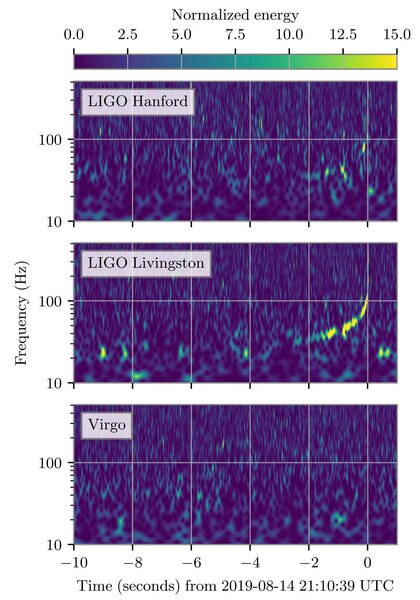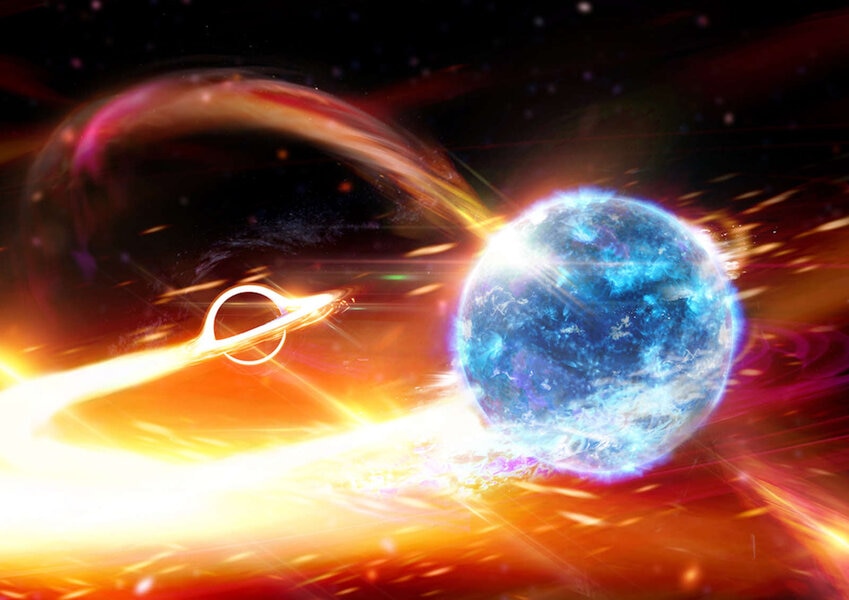Create a free profile to get unlimited access to exclusive videos, sweepstakes, and more!
A big black hole just ate a much smaller black hole. Or a neutron star. Maybe.

Eight hundred million light years from Earth, two massive cosmic objects merged after a long in-spiraling dance, the violent outburst of energy at the end literally shaking the fabric of spacetime. One of these objects was a big black hole. The other was… well, something. It's not clear what: Either a very large neutron star on the thin hairy edge of becoming a black hole, or the smallest black hole ever seen.
Either way, this is very cool.
The event itself is called GW190814 — GW for Gravitational Wave, followed by the date: 14 August, 2019. Gravitational waves are ripples in spacetime emitted when massive compact objects merge. This was predicted by Einstein's theory of General Relativity, but these waves weren't directly detected until 2015, when a pair of merging black holes over a billion light years away from Earth were observed.
Since then about a dozen confirmed gravitational wave emitting events have been seen, including one from a pair of merging neutron stars, which was a very big deal. But for that one exception, all of these have been from two black holes that merged after orbiting each other for eons. Not only that, but the two black holes have almost always been very similar in mass.
But that's now changed. A paper has just come out analyzing GW190814, and the scientists found it has the most lopsided mass ratio ever seen.
One of the objects was 23 times the Sun's mass, making it very definitely a black hole. But the other was much lower in mass, between 2.5 – 2.67 Suns. That's… peculiar. It's certainly possible to have a black hole with that low a mass, but it's weird. Even weirder, though, would be if it were a neutron star. The most massive one ever found has 2.14 times the Sun's mass, which is perilously close to the upper limit such a beast can have without collapsing into a black hole. So finding a neutron star with an even higher mass is very unlikely! It's maybe not strictly impossible, but if I had to bet I'd put decent money on it being another black hole.
But that's cool too! It would be the lowest mass black hole ever detected, which is quite a find. So right away this is a pretty important discovery for astrophysics.
The mass of the second black hole puts in squarely in the so-called "mass gap." Black holes more than about 5 times the Sun's mass are seen pretty commonly, but none (or at least very few) are found between 2.5 to 5 solar masses. Theoretically speaking black holes like this can exist, though perhaps they're not all that common. But it's been an open question of whether they really are super rare, or that we just aren't very good at finding them. Our methods to look for black holes favor bigger ones, so maybe we're just missing them.
So if this second object is a black hole (again, bet that way) then this means they do exist and we can find them. It doesn't necessarily answer the question, but it does raise hopes that as we find more merging black holes, lower mass ones will be in the mix.
This is the most unequal-mass merger ever seen, and that brings up another cool thing. The gravitational waves are emitted by each black hole as they swing around the other. If they're the same mass/size then the waves we see are pretty much the same from both (which is usually the case). But if their masses are unequal, as in this case, the smaller black hole makes a wide orbit around their center of mass, and the bigger one makes a smaller orbit. That means the waves are different, and they create what are called multipoles, like harmonics in frequencies. If you pluck a guitar string it will vibrate at a certain frequency, but there will also be higher frequency vibrations as well called overtones*.
With gravitational waves (and other types of systems as well) these come in powers of two, so you get dipoles, quadrapoles, octapoles, and so on. That's good, because it breaks some symmetry seen in the signal that makes it hard to figure certain characteristics out. For example, distance and orbital angle are both tangled up in the signal, but if you can see the higher order stuff they can be separated (which is in part how the 800 million light year distance was found).
Still, this does leave the question about how this system formed. You need very massive stars to explode and form black holes (probably 15 times the Sun's mass or more), and generally speaking very massive stars in binaries have similar masses. So this system was special in some way. I was surprised to read that it may have formed in the disk of matter swirling around a supermassive black hole in the center of an active galaxy! Usually two unequally (but still very) massive stars would have a hard time hooking up, but in a dense disk of gas the physics makes it easier; the gas acts as a drag on the stars making it possible for them to become a binary.
It's also possible this was a triple system, with two stars orbiting each other, and a third farther out. If they passed closed to the 23 solar mass black hole, the third star could be ejected and the binary would fall into orbit around the black hole. The two stars could then merge, explode, and form the lower mass black hole. It's a bit of a Wile E. Coyote scenario, but it's possible.
I have it mention one more thing. These ripples in the fabric of space are small. Like small small. LIGO and Virgo, the two observatories that detected this gravitational wave event, use lasers and mirrors to measure them; the setup can detect incredibly small changes in the length the laser travels over its several kilometer journey bouncing between mirrors. As a ripple passes through the Earth, the distance between the mirrors changes by about 1/1000th the diameter of a single proton.
A. Single. Proton.
That's why it took so long to detect the first event after they were predicted in the early 20th century. It's basically Star Trek tech. Yet it can "hear" the merger of a pair of black holes (and even hear harmonies!) a large fraction of the way across the observable Universe.
Because that's just how cool science is.
*The gravitational waves can be converted to sound, and they sound like a chirp — the frequency increases as the black holes get closer, and the pitch rises rapidly right at the end. You can listen to the simulated merger sound for this binary with just the fundamental undertone here, and with the overtone harmonics here.





























